I wasn't entirely certain what you wanted- aggregation or setting new ticks, but here are a few options. See the relevant code for each plot.
If you don't want the grids on top of either image in the lower row of plots, simply remove the call to axd[…].grid()
from numpy.random import default_rng
from astropy.modeling import models
import matplotlib.pyplot as plt
from matplotlib.ticker import MultipleLocator
plt.rc('axes', titlesize=11)
rng = default_rng(0)
z = np.zeros((100, 100))
y, x = np.mgrid[0:z.shape[0], 0:z.shape[1]]
for _ in range(10):
g2d = models.Gaussian2D(amplitude=100,
x_mean=rng.uniform(0, z.shape[0]),
y_mean=rng.uniform(0, z.shape[1]),
x_stddev=3,
y_stddev=3)
z += g2d(x, y)
a2d = models.AiryDisk2D(amplitude=70,
x_0=rng.uniform(0, z.shape[0]),
y_0=rng.uniform(0, z.shape[1]),
radius=5)
z += a2d(x, y)
mosaic = [
['original', 'averaged', 'cax'],
['grid1', 'grid2', 'cax']
]
fig, axd = plt.subplot_mosaic(mosaic, figsize=(6, 6), gridspec_kw={'width_ratios': [1, 1, .1]})
# Top left plot
im = axd['original'].imshow(z)
axd['original'].set(xlabel='x Position (μm)', ylabel='y Position (μm)', title='AFM Image (Original)')
# Top right plot
m = z.reshape(10, 10, 10, 10).mean(axis=(1, 3))
axd['averaged'].imshow(m)
axd['averaged'].set(xlabel='x Position (μm)', title='AFM Image (Averaged to 10x10)')
# Lower left plot
axd['grid1'].imshow(z)
axd['grid1'].xaxis.set_major_locator(MultipleLocator(10))
axd['grid1'].yaxis.set_major_locator(MultipleLocator(10))
axd['grid1'].grid()
axd['grid1'].set(xlabel='x Position (μm)', ylabel='y Position (μm)', title='AFM Image (10x10; 1)')
# Lower right plot
axd['grid2'].imshow(z)
axd['grid2'].xaxis.set_major_locator(MultipleLocator(10))
axd['grid2'].xaxis.set_major_formatter(lambda tick, val: f'{tick // 10:g}')
axd['grid2'].yaxis.set_major_locator(MultipleLocator(10))
axd['grid2'].yaxis.set_major_formatter(lambda tick, val: f'{tick // 10:g}')
axd['grid2'].set(xlabel='x Position (μm)', title='AFM Image (10x10; 2)')
axd['grid2'].grid()
fig.colorbar(im, cax=axd['cax']).set_label('Height (nm)', rotation = 270, labelpad=10)
fig.tight_layout()
plt.show()

To create a plot with just the lower right quadrant of the above, you can use the following code:
Do note that I made a few changes to the underlying mechanics (using MaxNLocator instead of MultipleLocator to ensure the plot will have 10 bins regardless of the size of the dataset.)
from numpy.random import default_rng
import numpy as np
from astropy.modeling import models
import matplotlib.pyplot as plt
from matplotlib.ticker import MaxNLocator
rng = default_rng(0)
z = np.zeros((100, 100))
y, x = np.mgrid[0:z.shape[0], 0:z.shape[1]]
for _ in range(10):
g2d = models.Gaussian2D(amplitude=100,
x_mean=rng.uniform(0, z.shape[0]),
y_mean=rng.uniform(0, z.shape[1]),
x_stddev=3,
y_stddev=3)
z += g2d(x, y)
a2d = models.AiryDisk2D(amplitude=70,
x_0=rng.uniform(0, z.shape[0]),
y_0=rng.uniform(0, z.shape[1]),
radius=5)
z += a2d(x, y)
fig, ax = plt.subplots()
im = ax.imshow(z)
# Create 10 ticks along X axis
# - whose labels correspond to tick position (instead of value)
ax.xaxis.set_major_locator(MaxNLocator(10))
ax.xaxis.set_major_formatter(lambda x, pos: pos)
# Create 10 ticks along Y axis
# - whose labels correspond to tick position (instead of value)
ax.yaxis.set_major_locator(MaxNLocator(10))
ax.yaxis.set_major_formatter(lambda x, pos: pos)
ax.set(xlabel='x Position (μm)', title='AFM Image (10x10)')
ax.grid()
fig.colorbar(im, ax=ax).set_label('Height (nm)', rotation = 270, labelpad=10)
plt.show()



